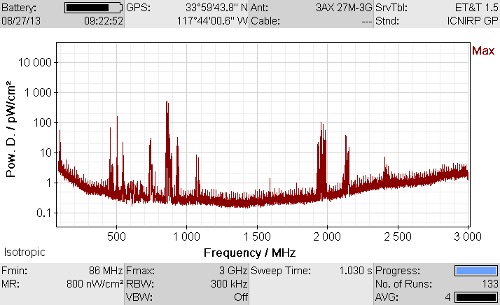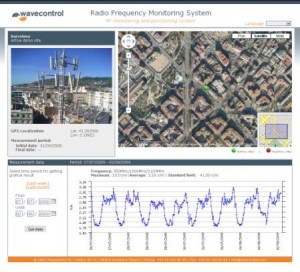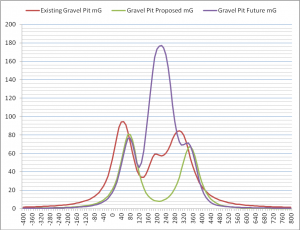- Call
 (760) 804-9400
(760) 804-9400 - Call
 (760) 804-9400
(760) 804-9400 - Providing Services In California & Beyond
 (760) 804-9400
(760) 804-9400 (760) 804-9400
(760) 804-9400 Exposure to high electromagnetic fields has become a concern due to potential health effects and interference issues with sensitive analytical and research equipment. The most common sources for high electromagnetic fields include proximity to power lines, transformers or appliances, flaws in the internal building’s wiring system and stray currents on utility pipes. We conduct an EMF test, assess EMF levels and remediate the electromagnetic field exposures.
Exposure to high electromagnetic fields has become a concern due to potential health effects and interference issues with sensitive analytical and research equipment. The most common sources for high electromagnetic fields include proximity to power lines, transformers or appliances, flaws in the internal building’s wiring system and stray currents on utility pipes. We conduct an EMF test, assess EMF levels and remediate the electromagnetic field exposures.
Magnetic fields are produced by the current flow in the wiring systems. Studies by the California Department of Health Services have shown that flaws in the building’s wiring system are a significant source of elevated magnetic fields. These wiring errors are also electrical code violations and should be eliminated.

Electric fields are produced by the voltage present on an electrical system even without a current flow. The higher the voltage, the stronger the field produced. Since the voltage can exist even when no current is flowing, the appliance does not have to be turned on for an electric field to exist. Common electric field sources in residential buildings are unshielded internal wiring (Romex cable) inside the walls, power cords for reading lights, alarm clocks and appliances. Once identified, the electric fields can be eliminated relative easily.
We measure the various EMF fields with professional electromagnetic field testing equipment and find solutions to creating low EMF and RF environments.
The level of electromagnetic fields can vary significantly over time. Data logging at sites allows observing field fluctuations over a period of time, identifies circuits, equipment activation and source identification. In conjunction with available current load data, extrapolation can be made on projected EMF field levels.
Remote Electromagnetic Field Testing Service by EMF & RF Solutions
 Our electromagnetic environments have dramatically changed over the last decade. Every day new wireless devices and application make their way into every aspect of our daily life, dramatically changing our radio frequency (RF) exposure. Common RF sources are cell towers and cell antennas, cell phones, wireless networks and router, DECT cordless phone, smart meter and baby monitors.
Our electromagnetic environments have dramatically changed over the last decade. Every day new wireless devices and application make their way into every aspect of our daily life, dramatically changing our radio frequency (RF) exposure. Common RF sources are cell towers and cell antennas, cell phones, wireless networks and router, DECT cordless phone, smart meter and baby monitors.
Do you want to know what you are being exposed to? Or want to create a low RF environment as part of a healthy green building? We can help. With our state-of-the-art spectrum analyzers, antennas and broadband, meters we test, measure and assess your radio frequency (RF) spectrum and provide field reduction solutions.
 We provide independent third party RF exposure assessments for occupants in commercial and residential buildings. With our Narda Selective Radiation Meter (SRM 3006), we assess a frequency range from 29 MHz to 6 GHz with one instrument. We identify the different cellular frequency bands present, wireless networks, FM and TV transmissions and radar emissions. Once the individual RF sources are identified, we assess and record the power density levels. Our written reports document the measurement results in graphs and tables. We compare the obtained results in relationship to common background levels, US and international regulatory maximum exposure standards, and international precautionary guidelines.
We provide independent third party RF exposure assessments for occupants in commercial and residential buildings. With our Narda Selective Radiation Meter (SRM 3006), we assess a frequency range from 29 MHz to 6 GHz with one instrument. We identify the different cellular frequency bands present, wireless networks, FM and TV transmissions and radar emissions. Once the individual RF sources are identified, we assess and record the power density levels. Our written reports document the measurement results in graphs and tables. We compare the obtained results in relationship to common background levels, US and international regulatory maximum exposure standards, and international precautionary guidelines.
25+ years of experience in RF measurement.
 Portable and continuous RF monitoring systems make it possible to monitor RF field levels generated by telecommunication facilities or other sources over time. Stationary monitoring devices can be installed near transmitters (antennas) or sensitive locations such as schools, hospitals or your building. The system is able to easily display the high, low and average readings and you can set an alarm function for specific RF levels. These systems make it possible to continually monitor the strength of the fields generated by telecommunication facilities and publish the data obtained in regular automatic reports.
Portable and continuous RF monitoring systems make it possible to monitor RF field levels generated by telecommunication facilities or other sources over time. Stationary monitoring devices can be installed near transmitters (antennas) or sensitive locations such as schools, hospitals or your building. The system is able to easily display the high, low and average readings and you can set an alarm function for specific RF levels. These systems make it possible to continually monitor the strength of the fields generated by telecommunication facilities and publish the data obtained in regular automatic reports.
The system consist of a permanently mounted probe which sends the data to a server where the information is stored and processed to allow real time review or evaluation by day, week, month or year.
Buyer’s awareness for electromagnetic fields and the presence of power lines or cell towers in the vicinity of their subject property has increased. EMF and RF surveys and accurate measurements are becoming a part of the due diligence inspections. Power transmission line, main distribution lines, step down transformers and flaws in the internal building wiring can cause high EMF levels in residential buildings. Wiring errors in electrical systems are often the source for elevated field and are also code violations.
We conduct spot measurements at the four (4) corners of the property, outside of the building and in each livable room. Our real estate surveys are performed in a timely manner for you and accompanied by a written report with reference levels meeting your deadlines. The magnetic flux density (EMF levels) are measured and reported in milliGauss (mG) or nano Tesla.
Magnetic fields on power lines can vary with the current load conditions on the lines. To provide you with a more accurate picture if the EMF levels over time, we can monitor the field levels for longer time periods such as 24 or 48 hours or more with data logging devices placed in the concern areas.
 The level of magnetic fields from power lines can vary significantly over time due to electrical consumption (load) patterns. Data logging at sites allows observing field fluctuations over a period of time. This is helpful to determine field levels adjacent to power lines under different load conditions. The data can support decisions regarding development of the building site or interference with sensitive building applications.
The level of magnetic fields from power lines can vary significantly over time due to electrical consumption (load) patterns. Data logging at sites allows observing field fluctuations over a period of time. This is helpful to determine field levels adjacent to power lines under different load conditions. The data can support decisions regarding development of the building site or interference with sensitive building applications.
With our software we are able to scientifically predict and model EMF levels for existing power transmission lines, new transmission line corridors, line upgrades or alterations.
This is a good question but not easily answered. We have regulatory maximum exposure levels as well as precautionary action levels. However, there is a great discrepancy between these two evaluation criteria. The regulatory levels are very high and lenient and the precautionary levels reflect common low exposures. In short, the safest way is to identify existing EMF and RF sources and reduce them to low levels. Yes, it can be done.
The lowest RF emission and exposure is always a wired system. Can we achieve low RF environments with low RF levels and have a functioning wireless system? The answer is Yes. Many of the wireless systems installed, especially in residential buildings, are often overpowered for normal use. Routers (access points) can be located away from occupants or they can be shielded. The technology is available and we can help.
Electrical power systems generate magnetic and electric fields extending from the conductors. Magnetic fields are produced by the current flow in a conductor. The AC magnetic field is scientifically referred to as the “magnetic flux density” and is measured in units of milliGauss (mG) in the United States and in Tesla (T) in Europe. Magnetic fields are relatively easily measured with direct reading instruments because they extend in a circular pattern from the conductor (wire).
Electric fields are produced by the voltage present on a conductor even without a flowing current. Electric fields are measured in units of Volts per meter (V/m). Electric fields are significantly more difficult to measure because the field emitted from the source wants to reach the ground. The person conducting the measurements becomes part of this pathway and alters the electric field lines and its results.
This question is not easily answered. First, what is considered safe? The Federal Communications Committee (FCC) has set maximum permissible exposure limits for the general public. However, they are based solely on thermal effects and you have to almost hug the antenna before you reach this level. Concerned scientist and professional associates, addressing non-thermal effects, have provided proactive threshold levels which are 4 to 5 orders of magnitude lower.
Secondly, there are the specifics on the cell tower as well as its location. We have many variables having an influence. Examples include: the type and quantity of antennas that are present, the direction in which they are emitting, direct or indirect line of site, and the materials that make up your building, and so on. The most reliable way is to test the RF levels present and then compare the results to precautionary and regulatory action levels. Our surveys and reports do just that.
There are no regulatory maximum exposure limits for electromagnetic fields (EMF) from power lines for the general public. What we do have are the precautionary action levels from different entities. The types of power line and its wire configuration have an impact on the extent of the field. Based on our measurements with major power line, EMF levels drop down to ambient level after 600 – 900 feet. Otherwise, if in doubt, test it out.
Many individuals have purchased consumer instruments to measure EMF and RF levels. We have heard about many strange measurement results from people who call us. There are 3 basic parts to the questions. First, do you have the right instrument for the task? Secondly, do you know how to operate instrument properly? Thirdly, do you know what these reading mean?
In general, inexpensive consumer instruments are not as accurate as professional equipment. However, they a great indicator tool to identify EMF and RF sources or the absence of them, if used correctly. When implementing field reduction methods, professional instrumentation should be used to properly assess the before and after conditions.